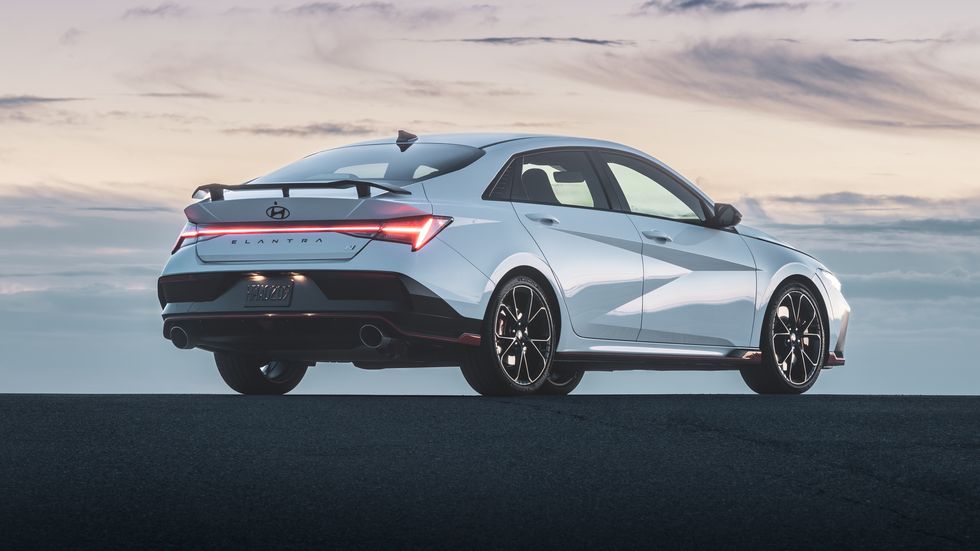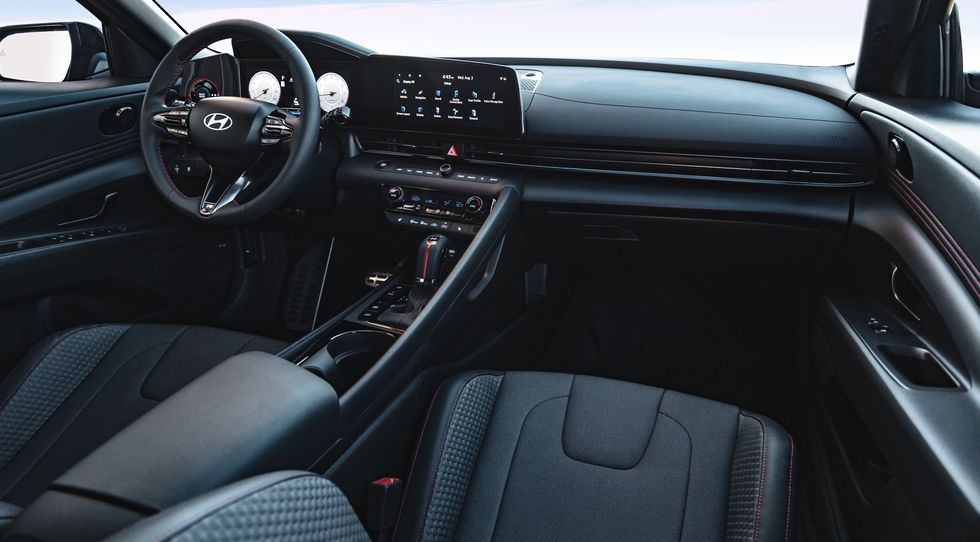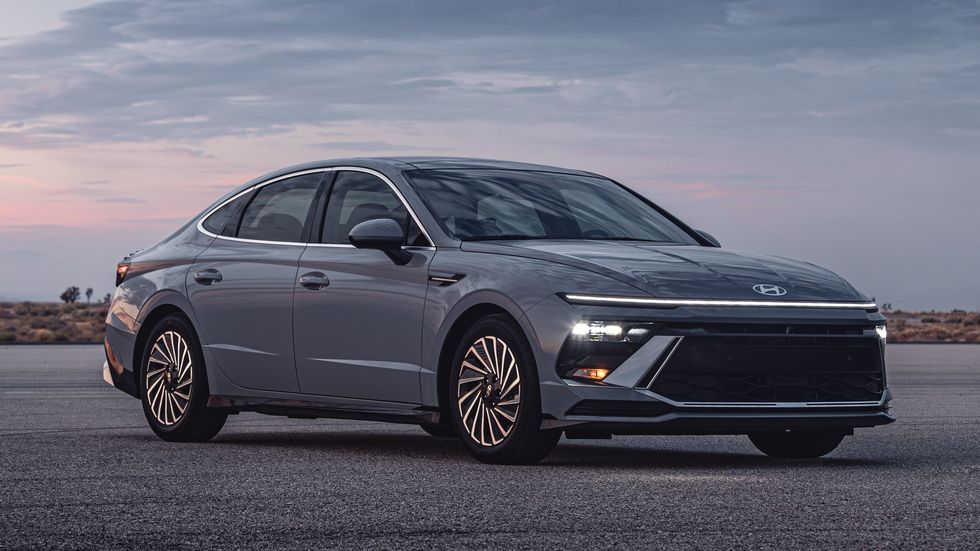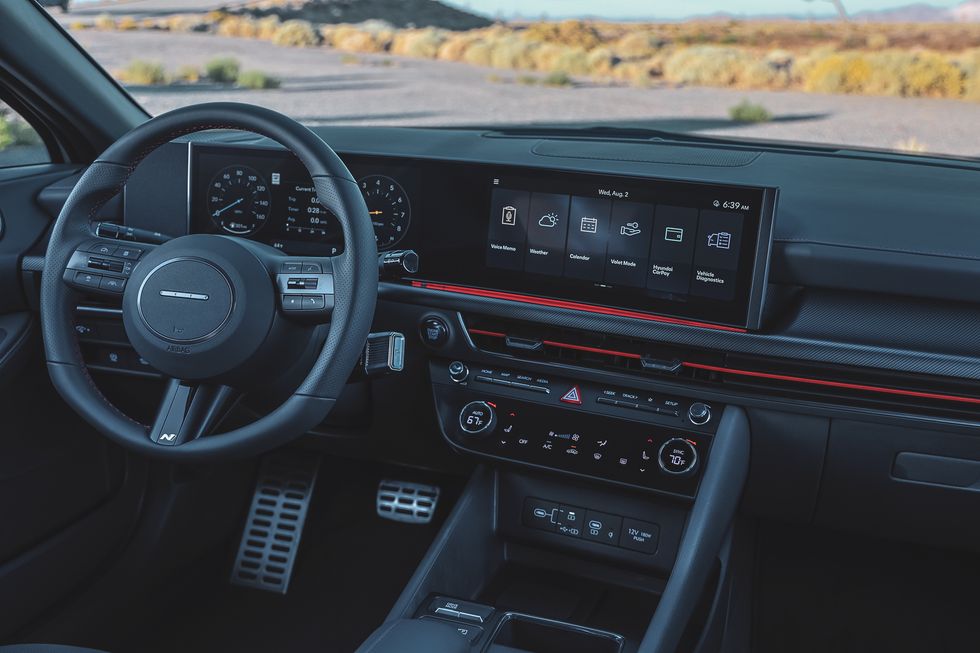- Hyundai sells plenty of crossovers and even electric vehicles, but company executives say their commitment to the sedan is here to stay.
- Refreshing its entry-level and midsize sedan offerings, the Elantra and Sonata, Hyundai is adding better looks, new infotainment, and more performance.
- The VW GTI-beating Elantra N gets more chassis bracing and better tuning, while the Sonata Hybrid adds regenerative braking and a tech-heavy interior for 2024.
It’s not uncommon to hear mourning cries from enthusiasts and affordable car buyers that the sedan is a by-gone way of life. That’s not entirely true, however. Sure, brands like Ford stopped selling sedans, but manufacturers like Hyundai are picking up the slack.
The Korean automakers offer three separate sedan platforms, and that’s a paired-down sedan lineup compared to five years ago. More importantly, its sedans are all relatively good, too, as Hyundai continues its affordable but quality car-selling mission.
Of course, there are a few changes for the 2024 model year, specifically on the Hyundai Elantra and Hyundai Sonata.
With a $22,065 starting MSRP in 2023, the Hyundai Elantra is the second cheapest model in its entire fleet and also the entry-level sedan offering. And it’s getting a major makeover for 2024, starting with its front fascia. Thinner LED daytime running lights connect a new two-piece grille, adorned with a 2D stainless steel Hyundai emblem.
Hyundai offers six different trims of the Elantra, ranging from the base model to a plug-in hybrid and the track-ready N-version, meaning a newly designed range of 15-, 16-, 17-, and 18-inch alloy wheels is part of the refresh. Four additional color choices (Ecotronic Gray, Ultimate Red, Exotic Green, and Amazon Gray) are new for 2024 as well.
But the real upgrades to the Elantra lineup for 2024 aren’t cosmetic. In fact, it’s the addition of new rear side airbags and a new rear seatbelt reminder on all trims that caught our eye. The Insurance Institute for Highway Safety has been sounding the alarm about rear airbags and the importance of seatbelt reminders, and it seems Hyundai is listening.
If you’re into sporty driving, it’s hard to overlook the Hyundai Elantra N. Competing with the Volkswagen GTI and Honda Civic Si, the Elantra N has won the hearts of the Autoweek staff with its raucous charm. And it’s supposed to get even better for 2024, with a host of handling and power improvements.
Given the likelihood of wheel hop on those inevitable first-gear clutch dumps, Hyundai has reinforced the engine mount membrane as well as the G bushing, limiting engine vibration and front-end yaw. The rear suspension supports were also changed from rubber to urethane in an effort to stiffen the chassis and limit body roll.
Given the wide Elantra lineup, Hyundai says it is maintaining a gasoline-powered 2.0L engine, a 2.0L turbo-4, a 1.6L turbo four-cylinder, and a 1.6L hybrid electric for 2024. But you don’t have to settle for an Elantra if you want performance-oriented fun or electrified efficiency.
That’s because Hyundai also offers the Sonata—a midsize family sedan up against the Honda Accord and Toyota Camry. Not always the most exciting-looking model, Hyundai is changing up the Sonata’s look and ideally its reputation as well.
By dropping the front grille to the floor, the new Sonata has an Ioniq 6-like look to it, aided by the wide-set headlight bar spanning across the entire front end. Out back, the Sonata receives a connected light bar with capital H-shaped brake lights, a move that allegedly increases visibility. It’s a “state-of-the-art aircraft look,” Hyundai says.
But there is something funky going on inside the new Sonata. It also looks BMW-like, and it might be because the hardware is BMW-derived. New for 2024, the Sonata is sporting a one-piece 12.3-inch driver information cluster and 12.3-inch audio-video navigation system, just like an M340i.
Wireless Apple CarPlay and Android Auto are now standard across the Sonata lineup, as is a 12-speaker Bose Premium Sound System. Better yet, all of this technology can be updated over the air now, according to Hyundai. But middling luxury isn’t what the Sonata is built for.
In fact, Hyundai is pushing its Sonata N-Line for 2024, re-stating its performance features in the model year reveal. But the N-Line isn’t just a gimmick, sporting Hyundai’s Active Sound Design exhaust program, Launch Control, and N Powershift.
More important than launch control and piped-in exhaust noises, however, is the addition of the HTrac AWD system for Sonatas equipped with the 2.5-liter inline-four, naturally aspirated engines. Other powertrains for 2024 include an N-Line model-specific 2.5-liter turbo inline-four and a unique 2.0-liter hybrid four-cylinder as well.
The Sonata Hybrid also includes paddle shifters and a regenerative braking mode for the first time this year.
Hyundai has yet to reveal prices, delivery dates, or official power and range numbers for either sedan, though the differences from 2023 are overall marginal. As such, we suspect Hyundai will add a thousand dollars here and there (depending on trim level), though it’s unlikely we’ll see large price bumps. Either way, it’s clear Hyundai is dedicated to the future of the sedan.
“The car market has stabilized, and Hyundai remains committed to sedans as a part of our lineup at a time when some manufacturers have abandoned the segment. Our car mix is higher than the industry,” said José Muñoz, president and Global COO of Hyundai Motor Company.
Do you think sedans will continue to sell by 2035? How will an EV transition affect the sedan market? Please share your thoughts below.
Associate Editor
A New York transplant hailing from the Pacific Northwest, Emmet White has a passion for anything that goes: cars, bicycles, planes, and motorcycles. After learning to ride at 17, Emmet worked in the motorcycle industry before joining Autoweek in 2022. The woes of alternate side parking have kept his fleet moderate, with a 2014 Volkswagen Jetta GLI and a 2003 Honda Nighthawk 750 street parked in his South Brooklyn community.
Read the full article here







